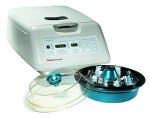Microcoagulation testing
Q: Recently weve had a couple of instances when a micro method for coagulation would have been helpful. I would like to know if there are micro methods for coagulation tests. Also, what quality control procedures are needed?
A: Presumably you would like to perform prothrombin times, partial thromboplastin times, and/or activated coagulation times. There are a number of point-of-care (POC) devices now being marketed that could be helpful to you. They use a variety of technologies, and most of them use microscopic skin puncture specimens. Prothrombin time is the most widely available POC coagulation test, and the results are reported in seconds and also, many times, as INRs. The FDA has approved several of these devices for use. Some of these devices have even been successfully used for home testing by patients receiving long-term warfarin anticoagulation.
The measurement of the partial thromboplastin time has sometimes been problematic, but this has improved. In some settings, the activated coagulation times are also done using these devices. Most of these instruments have quality control systems incorporated into the protocols either as discrete control plasmas or controls that are run parallel with the patients sample. Electronic controls are also included where appropriate.
If you choose to use such a device, be sure to coordinate the results with the same coagulation tests done within the central laboratory so that reference and therapeutic ranges are similar. The indicated reference includes additional details about such devices and includes a number of references that may be of help1. CAP Today has specifications of the currently available point of care analyzers.2
John A. Koepke, M.D.
Professor Emeritus of Pathology
Duke University Medical Center
Durham, NC
References
1.Koepke, J.A. Point-of-care coagulation testing. Laboratory Medicine 31: 343-346, 2000
2. CAP Today, October 2000
Cell washer RPMs
Q: We have encountered manufacturing and repair problems with our blood bank cell washer that changed the RPMs. It does not spin at the RPMs it did when installed. We have been trying to get information regarding the correct RPMs, but have had no luck. We would like to know at what RPMs we should be spinning and the recommended time.
The spin time should be adequate to result in a dry cell button after decanting without losing cells. The size of the cell button should be the same after the last wash in all tubes as at the start of the cycle. You need to determine the spinning time for your system by experimenting with different times and selecting the time that produces a good cell button.
Diane Schacht
Manager Transfusion Service
Oregon Health and Science University
Portland, OR
Reference
1. AABB Technical Manual 13th Edition, 1999, AABB Press, Bethesda, MD
Test costs averages
Q: I am seeking information on the national average or best practice benchmarking on the average cost per test, both labor and nonlabor for laboratory testing. How would I obtain this information?
A: CAPs Laboratory Management Information Program (LMIP) is the best source for collecting your labs cost data and comparing it with data from other labs. Cost information comparisons need to be done in a standardized way so that the data are collected in the same way for each lab. Also, there are factors such as the test mix, services provided, lab size, geographic location, and type (hospital, clinic, independent lab) that influence the costs. For this reason, the LMIP program has strict definitions of what constitutes a test to be counted, and it compares a lab with other labs of similar characteristics.
LMIP is a subscription program with 770 participating labs. Its reports are detailed, providing comparative data on a labs costs, numbers of personnel, productivity, supply, and maintenance costs. As a lab subscribes over a number of years, LMIP charts its performance over time. The reports highlight problem areas.
Daniel M. Baer, M.D.
Professor Emeritus
Department of Pathology
Oregon Health and Science University
Portland, OR
Who can draw blood alcohol?
Q: We have been told that only RNs and physicians can draw a specimen for blood alcohol in the emergency room for the state police. Is this true?
A: There is no federal law, guideline, or standard that I am aware of specifying whom in a facility is allowed to draw forensic blood alcohol specimens. The fact that only RNs or physicians are allowed to draw such specimens in your facility indicates that it is either a policy of your facility or a statute specific to your state or county. The former can be easily debated and changed; the latter cannot. You can easily confirm that the policy is based on a state or county statute by posing the question to your local prosecuting attorneys office. If the assignment is based on your facilitys policy and you think it should be readdressed, recruit your medical director to raise the issue with the hospital administration or medical staff.
Dennis Ernst, MT (ASCP)
Director
The Center for Phlebotomy Education
Ramsey, IN
Daniel M. Baer is professor emeritus of laboratory medicine at Oregon Health and Science University in Portland, OR, and a member of MLOs editorial advisory board.
© 2002 Nelson Publishing, Inc. All rights reserved.



